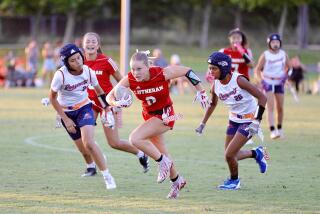Work Begins to Extend Subway Line Into Valley : Transportation: North Hollywood is expected to be linked with Downtown by the year 2000.
- Share via
The thunder of a 200-foot-long tunneling machine announced the birth of the subway age in the San Fernando Valley on Monday as workers began boring the subterranean path for the Metro Red Line cars that will link the Valley to Downtown Los Angeles.
The mammoth excavator rumbled to life beneath Lankershim Boulevard in North Hollywood shortly before 10:30 a.m., punching through a foot of earth to inaugurate a project that will stretch south for two miles to Universal City.
Barring mishaps, twin tunnels from North Hollywood will link up with tubes beneath Hollywood Boulevard to create a seamless ride from Union Station through the city’s historic movie district and underneath the Santa Monica Mountains to the eastern Valley by the year 2000.
“Each time we begin a new link, we’re closer to providing a complete and modern transit system that the people of the region will be able to use for decades to come,” said Franklin E. White, chief executive officer of the Metropolitan Transportation Authority.
Mindful of the construction debacle that led to a temporary halt in federal funding for the rail line, MTA officials stressed that they will be guarding against a repeat of the problems that caused Hollywood Boulevard to sink nearly a foot in July. Although funding was unfrozen and tunneling in the area eventually resumed, that project is again at a standstill because the ground dropped another two inches in places last week.
Contractors are applying lessons from last summer to the North Hollywood segment, which will run through soils similar to those beneath Hollywood Boulevard, according to project manager Charles Stark. Work crews are required to use steel struts instead of wooden ones inside the new tunnels and to survey for leaking water mains.
“We’ll be doing constant monitoring of settlement,” Stark said.
The contractor, Obayashi Corp. of San Francisco, also will be on alert for such volatile gases as hydrogen sulfide and methane. But “neither we nor the contractor nor Cal/OSHA expect to find any,” Stark said.
Construction in North Hollywood commenced Monday on the east tunnel, with work on the west side to start in a month. As workers scurried beneath steel beams and catwalks latticed over a noisy excavation shaft 70 feet deep, the tunneling machine scooped out a chunk of earth and inched forward under the intersection of Lankershim and Weddington Street.
Officials estimate that construction will progress from 50 to 200 feet daily, with crews working around the clock five or six days a week. The machines will bore through earth that once lined the bottoms of ancient oceans.
A report by a private engineering firm last fall to the Federal Transit Administration warned that “these soils are referred to as ‘collapse prone’ and create the most problems when wetted.”
In an effort to head off any excessive subsidence, the MTA is closely following the report’s recommendations. In addition to the steel wedges, the agency has a stockpile of other steel reinforcements close by.
Excavation from North Hollywood to Universal City should take about six months, officials said. Pouring concrete will take another 12 to 18 months. The expected completion date for the $65.4-million link is February, 1997.
Tunneling south from Universal City to Hollywood is scheduled to begin late this year or early next year to prepare for an opening of the Red Line extension from Hollywood to the Valley in July, 2000.
MTA officials said they do not expect the tunneling to cause any disruptions to local businesses or traffic.
When the core of the Red Line system--the 17.4-mile route from Union Station to North Hollywood--is finished in five years, the MTA expects daily ridership to average about 325,000 passengers, including 38,300 boardings between the North Hollywood and Hollywood/Highland stations.
The terminus at North Hollywood is a key element of an ambitious plan to reinvigorate the “downtown” portion of that community, a major shopping and entertainment district after World II that has fallen into disrepair.
With a subway station, residents will have easier access to the restaurants and night life spots planned for the area. The neighborhood has several live theaters, and plans call for construction of an additional facility with as many as 12 theaters under one roof.
Last week, the Los Angeles Planning Commission took the first steps toward allowing artists in the area to convert commercial buildings into lofts and studios.
Kevin McCarney, president of the Universal City-North Hollywood Chamber of Commerce, said redevelopment efforts aim at creating a Bohemian enclave that would attract residents from throughout the city, including patrons of the CityWalk attraction a quick subway ride away.
“It’s going to allow people who go to CityWalk to very quickly make their way to the live theater district in North Hollywood, which is just one stop away,” McCarney said. “It stretches the positive economic impact into an area that really needs revitalization.”
Times staff writer Richard Simon contributed to this story.
More to Read
Sign up for Essential California
The most important California stories and recommendations in your inbox every morning.
You may occasionally receive promotional content from the Los Angeles Times.














